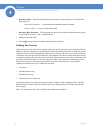
65
Chapter 4:
SFE2000/SFE2000P Gigabit Ethernet Switch Reference Guide
Chapter
4
– Unchecked — Indicates the port is currently unlocked. This is the default value.
– Checked — Indicates the port is currently locked.
• Learning Mode — Defines the locked port type. The Learning Mode field is enabled only if Locked
is selected in the Interface Status field.The possible field values are:
– Classic Lock — Locks the port using the classic lock mechanism. The port is immediately
locked, regardless of the number of addresses that have already been learned.
– Limited Dynamic Lock — Locks the port by deleting the current dynamic MAC addresses
associated with the port. The port learns up to the maximum addresses allowed on the port.
Both relearning and aging MAC addresses are enabled.
In order to change the Learning Mode, the Lock Interface must be set to Unlocked. Once the mode is
changed, the Lock Interface can be reinstated.
• Max Entries — Specifies the number of MAC addresses that can be learned on the port. The Max
Entries field is enabled only if Locked is selected in the Interface Status field. In addition, the
Limited Dynamic Lock mode is selected. The default is 1.
• Action on Violation — Indicates the action to be applied to packets arriving on a locked port. The
possible field values are:
– Forward — Forwards packets from an unknown source without learning the MAC address.
– Discard — Discards packets from any unlearned source. This is the default value.
– Shutdown — Discards packets from any unlearned source and shuts down the port. The port
remains shut down until reactivated, or until the device is reset.
• Enable Trap — Enables traps when a packet is received on a locked port. The possible field values
are:
– Enable — Enables traps.
– Disable — Disables traps.
• Trap Frequency — The amount of time (in seconds) between traps. The default value is 10 seconds.
3. Modify the relevant fields.
4. Click Apply. Port security is modified, and the device is updated.


















